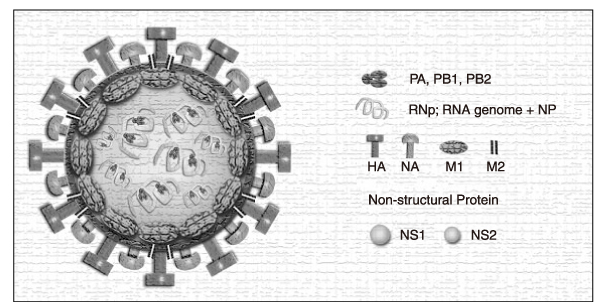J Korean Med Assoc.
2005 Dec;48(12):1195-1205. 10.5124/jkma.2005.48.12.1195.
Avian Influenza
- Affiliations
-
- 1Department of Internal Medicine, Korea University College of Medicine, Gu-Ro Hospital, Korea. heejinmd@korea.ac.kr
- KMID: 2015631
- DOI: http://doi.org/10.5124/jkma.2005.48.12.1195
Abstract
- Influenza is an acute febrile disease caused by influenza virus (type A or B). Influenza virus is the major culprit of viral diseases in the respiratory tract with the highest mortality in the human history and can affect 10~40% of the general population within only 4 weeks when it is epidemic. In immunocompetent individuals, influenza infection is mostly limited as 'flu' for several days, but in immunocompromised hosts such as elderly individuals and those with chronic diseases it can result in serious complications such as pneumonia and can also aggravate underlying diseases requiring admission and increasing mortality. Despite the wide application of influenza vaccines for the last decades, influenza still remains an important health issue due to the increase of the susceptible individuals and the recent outbreaks of avian flu along with the emergence of new strains.
Keyword
MeSH Terms
Figure
Cited by 1 articles
-
Clinical Use of Tamiflu (Oseltamivir)
Mee Soo Chang, Jun Hee Woo
J Korean Med Assoc. 2008;51(8):757-763. doi: 10.5124/jkma.2008.51.8.757.
Reference
-
1. World Health Organization. WHO interim guidelines on clinical management of humans infected by influenza A(H5N1). 2004. 02. 20.2. Webster RG, Yakhno M, Hinshaw VS, Bean WJ, Murti KG. Intestinal influenza: replication and characterization of influenza viruses in ducks. Virology. 1978. 84:268–278.
Article3. Rogers GN, Paulson JC. Receptor determinants of human and aminal influenza virus isolates: differences in receptor specificity of the H3 hemagglutinin based on species of origin. Virology. 1983. 127:361–373.
Article4. Rogers GN, Paulson JC, Daniels RS, Skehel JJ, Wilson IA, Wiley DC. Single amino acid substitutions in influenza haemagglutinin change receptor binding specificity. Nature. 1983. 304:76–78.
Article5. Salgado CD, Farr BM, Hall KK, Hayden FG. Influenza in the acute hospital setting. Lancet Infect Dis. 2002. 2:145–155.
Article6. Bridges CB, Kuehnert MJ, Hall CB. Transmission of influenza: implications for control in health care settings. Clin Infect Dis. 2003. 37:1094–1101.
Article7. Hien TT, Liem NT, Dung NT, et al. Avian influenza A (H5N1) in 10 patients in Vietnam. N Engl J Med. 2004. 350:1179–1188.
Article8. World Health Organization. . WHO inter-country-consultation: influenza A/H5N1 in humans in Asia. 2005. 05. 6~7. Manila, Philippines:9. Liem NT, Lim W. World Health Organization International Avian Influenza Investigation Team, Vietnam. Lack of H5N1 avian influenza transmission to hospital employees, Hanoi, 2004. Emerg Infect Dis. 2005. 11:210–215.
Article10. Apisarnthanarak A, Kitphati R, Thongphubeth K, et al. Atypical avian influenza (H5N1). Emerg Infect Dis. 2004. 10:1321–1324.11. de Jong MD, Cam BV, Qui PT, et al. Fatal Avian influenza A (H5N1) in a child presenting with diarrhea followed by coma. N Engl J Med. 2005. 352:686–691.
Article12. Beigel JH, Farrar J, Han AM, Hayden FG, Hyer R, Yuen KY, et al. Writing Committee of the World Health Organization (WHO) Consultation on Human Influenza A/H5. Avian influenza A (H5N1) infection in humans. N Engl J Med. 2005. 353:1374–1385.
Article13. Chotpitayasunondh T, Ungchusak K, Hanshaoworakul W, et al. Human disease from influenza A (H5N1), Thailand, 2004. Emerg Infect Dis. 2005. 11:201–209.
Article14. Hien TT, Liem NT, Dung NT, et al. Avian influenza A (H5N1) in 10 patients in Vietnam. N Engl J Med. 2004. 350:1179–1188.
Article15. Kaiser L, Briones MS, Hayden FG. Performance of virus isolation and Directigen Flu A to detect influenza A virus in experimental human infection. J Clin Virol. 1999. 14:191–197.
Article16. Leneva IA, Roberts N, Govorkova EA, Goloubeva OG, Webster RG. The neuraminidase inhibitor GS4104 (oseltamivir phosphate) is efficacious against A/Hong Kong/156/97 (H5N1) and A/Hong Kong/1074/99 (H9N2) influenza viruses. Antiviral Res. 2000. 48:101–115.
Article17. Gubareva LV, McCullers JA, Bethell RC, Webster RG. Characterization of influenza A /HongKong/156/97 (H5N1) virus in a mouse model and protective effect of zanamivir on H5N1 infection in mice. J Infect Dis. 1998. 178:1592–1596.
Article18. Leneva IA, Goloubeva O, Fenton RJ, Tisdale M, Webster RG. Efficacy of zanamivir against avian influenza A viruses that possess genes encoding H5N1 internal proteins and are pathogenic in mammals. Antimicrob Agents Chemother. 2001. 45:1216–1224.
Article19. Yen HL, Monto AS, Webster RG, Govorkova EA. Virulence may determine the necessary duration and dosage of oseltamivir treatment for highly pathogenic A/Vietnam/1203/04 influenza virus in mice. J Infect Dis. 2005. 192:665–672.
Article
- Full Text Links
- Actions
-
Cited
- CITED
-
- Close
- Share
- Similar articles
-
- Epidemiology and Pandemic Risk Assessment of Avian Influenza
- Avian Influenza: Should China Be Alarmed?
- The significance of avian influenza virus mouse-adaptation and its application in characterizing the efficacy of new vaccines and therapeutic agents
- The influenza virus: present and future of avian influenza in Hong Kong
- The Current Trend of Avian Influenza Viruses in Bioinformatics Research


